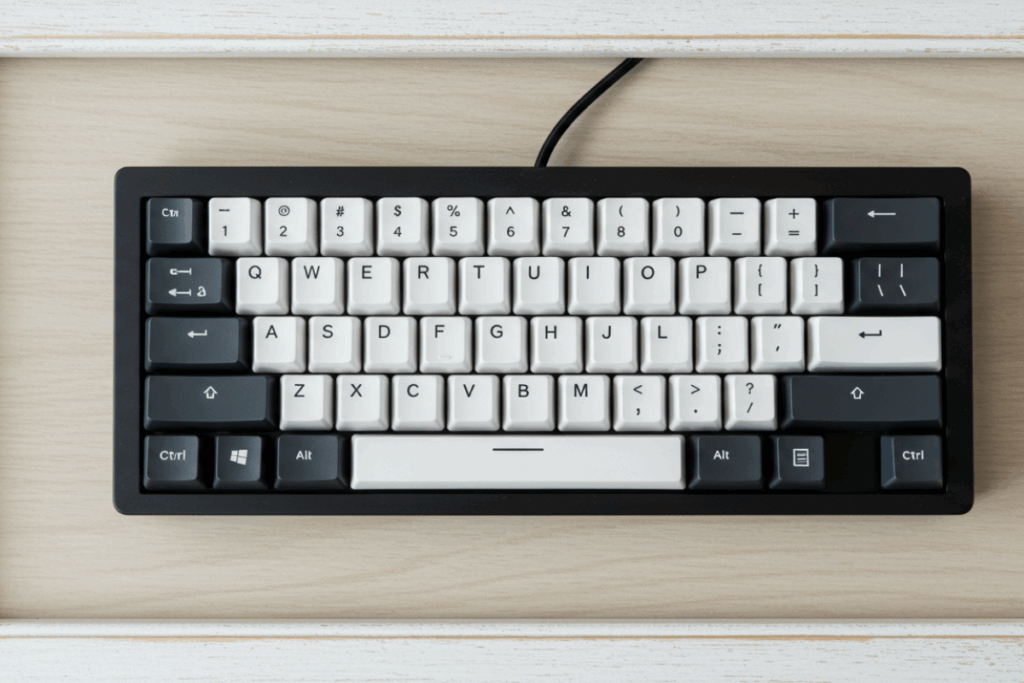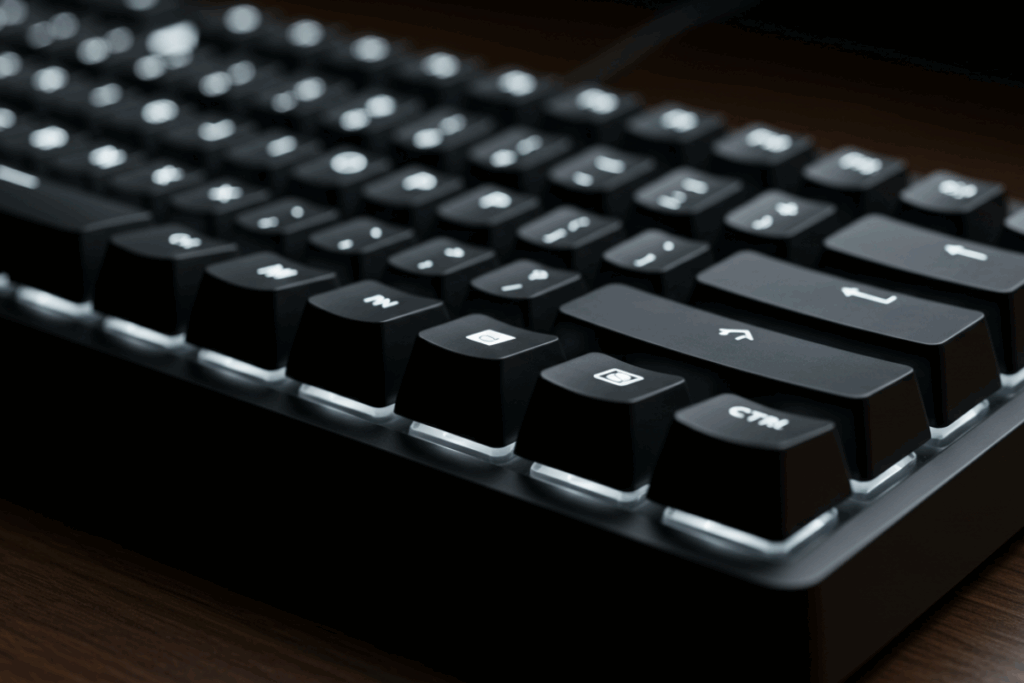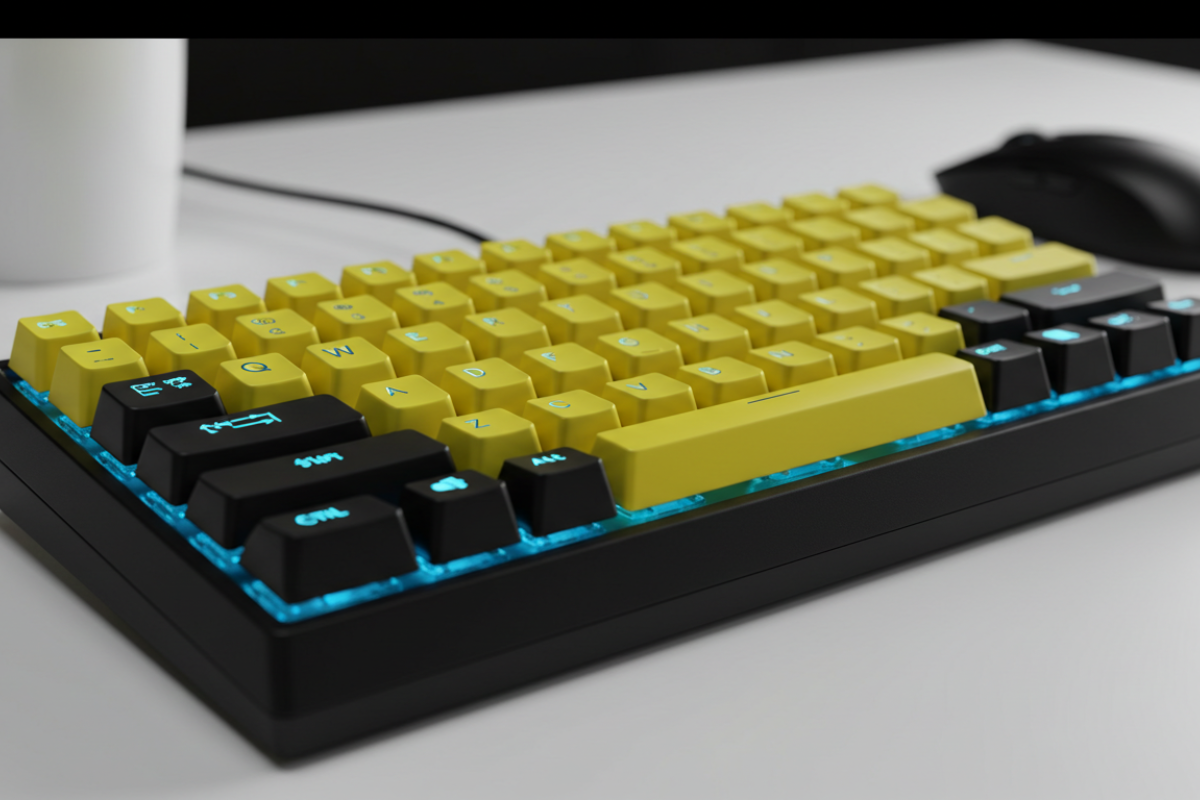This guide for Keyboards Technology helps you pick the right board. I explain what a mechanical keyboard is and the main parts: switches, keycaps, PCB, stabilizers, and case.
I cover core switch types (linear, tactile, clicky), sizes (full-size, tenkeyless, compact layouts), connectivity (wired, wireless, Bluetooth), and hot-swappable vs soldered PCBs. I set clear expectations from budget to premium, highlight what matters most—typing feel, sound, build quality, size, layout, connectivity, budget, and intended use—and finish with care tips and a simple buying checklist to make your first pick easy and confident.
Key Takeaway
- I pick hot-swap Keyboards Technology boards to swap switches without soldering.
- I try linear, tactile, and clicky switches to find the feel I like.
- I choose PBT keycaps and sturdy plates for longer life.
- I go compact (TKL or 65%) to save desk space and carry the keyboard easily.
- I use wired USB-C for low lag and trust Keyboards Technology support.
Why I recommend mechanical keyboards for beginners
Switching from a cheap membrane to a mechanical keyboard made my typing cleaner, reduced typos, and eased hand fatigue. For anyone starting out, mechanical keyboards for beginners deliver better feel, speed, and control.
How mechanical keyboards for beginners improve typing and gaming
Mechanical switches give clear feedback so each keystroke is easier to feel. Use tactile switches for typing, linear for smooth gaming, and expect features like N-key rollover and anti-ghosting for reliable inputs in intense games.
Feature comparison (quick):
| Feature | Membrane | Mechanical |
|---|---|---|
| Feedback | Soft, mushy | Clear, precise |
| Durability | ~5M presses | ~50M presses |
| Customization | Low | High (switches, caps, lighting) |
| Gaming perks | Limited | N-key rollover, fast actuation |
I saw my typing speed rise and in games combos felt more consistent. That matters when you spend hours at the desk.
My pick criteria at Keyboards Technology for the best mechanical keyboards for beginners
I choose boards that give a great first experience. These rules help new users get value fast.
| Criteria | Why it matters |
|---|---|
| Switch type | Good feel helps learning and comfort |
| Hot-swappable | Try switches without soldering |
| Price | Affordable options lower risk |
| Build & weight | Feels solid and lasts longer |
| Keycap material | PBT resists shine and wear |
| Connectivity | Wired for low lag; wireless for convenience |
| Support | Helpful warranty and fast help |
I test each keyboard by typing and gaming, check manuals and support, and only recommend boards that are easy for a beginner to love.
What I look for in a beginner keyboard
- Switch type: start with tactile or light linear switches.
- Hot-swappable: swap switches without tools.
- Layout & size: TKL or compact boards save desk space.
- Keycaps: prefer PBT for longevity.
- Build quality: a weighted board feels stable.
- Price: aim for value—no need to overspend.
- Connectivity: Wired for gaming; Bluetooth for casual use.
- Software & presets: easy tools for lighting and macros.
- Warranty & support: good support is essential.
How I choose a mechanical keyboard: simple steps
Focus on three things: size, switches, and build—these shape typing speed and desk setup.
Size
Match layout to desk and use:
| Size | Best for | Why |
|---|---|---|
| Full-size | Data entry, spreadsheets | Includes numpad |
| TKL (87 keys) | General use, gaming | Balanced; more mouse space |
| 60% / 65% | Small desks, portability | Compact; faster hand movement |
I moved from full-size to TKL and gained mouse space; a 60% fits in a bag like a paperback.
Switches
Try to feel and hear switches:
- Linear: smooth — great for fast gaming.
- Tactile: small bump — great for typing.
- Clicky: bump loud click — distinct audio feedback.
Check actuation force (e.g., 45g) — heavier switches can slow you down at first.
| Switch type | Feel | Good for |
|---|---|---|
| Linear | Smooth | Fast repeats, gaming |
| Tactile | Bumpy | Typing accuracy |
| Clicky | Bump click | Audible feedback |
Build
Look at case material, plate, stabilizers, and keycap quality. PBT keycaps last longer than ABS. Metal plates give firmer feedback. Press big keys to check wobble—cheap boards often skimp here.
Wired vs Wireless and when I pick each
I choose wired for lowest delay and no charging—ideal for competitive gaming and long sessions. I pick wireless for a tidy desk or portability; modern wireless can be fast but remember battery life.
| Factor | Wired | Wireless |
|---|---|---|
| Latency | Very low | Low to moderate |
| Convenience | Cable on desk | Clean look; portable |
| Power | No charging | Needs battery/charging |
| Best use | Competitive gaming, long sessions | Travel, minimal desks |
At Keyboards Technology I test both and look for stable wireless links and fast polling rates.

Quick buying checklist I use
- Layout: choose the right size for your desk.
- Switch type: try linear, tactile, and clicky.
- Keycaps: prefer PBT for lasting texture.
- Build quality: check plate and stabilizers; press big keys.
- Connection: Wired for low lag, wireless for clean setups.
- Budget: set a clear range; good options exist for many budgets.
- Brand trust: Keyboards Technology provides honest tests.
- Return policy: buy where you can return after trying switches.
Mechanical keyboard switch guide for beginners
If you’re shopping for mechanical keyboards for beginners, this guide saves time. I speak from testing and daily use; Keyboards Technology provides clear picks and reviews.
Switch types: tactile, linear, clicky
- Tactile: bump on actuation—great for typing.
- Linear: smooth travel—preferred by many gamers.
- Clicky: bump audible click—distinct but loud.
Start with tactile if unsure; it’s a versatile middle ground. Try a tester pack—feeling beats guessing.
| Switch Type | What it feels like | Best for | Typical example |
|---|---|---|---|
| Tactile | Bumpy, confirming | Typing, mixed use | Brown style |
| Linear | Smooth, no bump | Gaming, fast typing | Red style |
| Clicky | Bump loud click | Typists who like sound | Blue style |
How I test switches for sound and feel
- Press each switch 100 times, noting 10/50/100 impressions.
- Record sound in a quiet room and compare.
- Type a paragraph and play a fast game round; note comfort and speed.
Swap keycaps to hear tone changes—caps affect sound a lot.
Mechanical keyboard layouts explained
I help people choose mechanical keyboards for beginners by breaking down common layouts.
Full, TKL, and 60%
| Layout | Keys | Pros | Cons | Best for |
|---|---|---|---|---|
| Full-size | 104 | All keys present; easy number entry | Takes more desk space | Data entry |
| TKL (Tenkeyless) | ~87 | Keeps arrows; saves space | No numpad | Gaming, coding |
| 60% | ~61 | Very compact; portable | Layered function keys | Travel, small desks |
Pick based on daily needs—if you use the numpad often, keep full-size; if you want mouse room, go TKL.
ANSI vs ISO
Key differences: Enter shape, Left Shift size, and regional popularity. I pick whichever matches my typing habit; ANSI often has easier keycap availability.
| Feature | ANSI | ISO | Which I pick |
|---|---|---|---|
| Enter key | Wide horizontal | Tall L-shaped | Match your habit |
| Left Shift | Long | Shorter extra key | Try both |
| Popular regions | US | Europe | Pick per locale |
| Keycap availability | Very high | Slightly less | ANSI easier for swaps |
Match layout to desk and needs: measure desk width, consider mouse movement, and how often you carry the keyboard.
Hot-swappable keyboards and why I like them
Change switches without soldering
Hot-swappable keyboards let you change switches in minutes: no soldering, no mess. Pull a switch, push a new one—done. That’s ideal for anyone learning about mechanical keyboards for beginners.
What hot-swap means:
- The PCB has special sockets.
- Switches plug in and pull out.
- You can test many switch types fast.
Swap steps:
- Remove keycaps with a puller.
- Pull the switch straight out.
- Insert the new switch firmly.
- Replace keycap and test.
Hot-swap vs soldered: pros and cons
| Feature | Hot-swappable | Soldered |
|---|---|---|
| Change switches | Fast | Slow (soldering required) |
| Cost | Good for experimenting | Cheaper long-term if fixed |
| Repair | Easy | Need desoldering |
| Customization | Try many quickly | Any switch possible with effort |
| Durability | Fine | Slightly firmer long-term |
Pros for beginners: try before you buy, fix problems fast, learn switch types.
Cons: some cheap sockets may be loose; check pin count (3-pin vs 5-pin). For most beginners, I back hot-swappable as the easiest path.
Best hot-swappable choices I recommend
Pick by layout and build more than brand name:
- New to switches: Full-size or TKL.
- Want compact desk: 60% or 65%.
- Heavy typer: sturdy, weighty case.
- On a budget: entry hot-swap models.
Tips: look for 3-pin and 5-pin support, keep your familiar layout on day one, buy a basic switch tester, and read clear specs and reviews at Keyboards Technology.
Budget mechanical keyboards under $100: my affordable picks
I test a lot and buy budget boards so you don’t have to. These picks fit under $100 and deliver solid value.
| My pick | Price | Switches | Why I pick it |
|---|---|---|---|
| Keyboards Technology Compact 60 | Under $100 | Linear or tactile | Small, solid feel; great for tight desks |
| Keyboards Technology TKL Lite | Under $100 | Tactile recommended | Full keys without numpad; good build |
| Keyboards Technology Hot-Swap Starter | Under $100 | Hot-swap compatible | Try different switches without soldering |
What to expect from budget boards
- Plastic cases rather than metal.
- Stock switches (serviceable for daily use).
- Keycaps often ABS, which shine faster—can upgrade later.
- Some models include hot-swap (a big win).
- Stabilizers may need tuning for smoother sound.
Budget boards can be excellent first mechanical keyboards for beginners when you know what to expect.
Keycap materials: ABS vs PBT
| Feature | ABS | PBT |
|---|---|---|
| Feel | Smooth, softer | Slightly textured |
| Shine over time | Shines faster | Resists shine |
| Sound | Lighter, higher | Deeper, thockier |
| Cost | Cheaper | A bit pricier |
| My pick | Good for budget RGB | Personal favorite for typing |
I prefer PBT for long-term feel. If your starter board has ABS, upgrading keycaps later transforms the typing experience.
Mechanical keyboard maintenance and cleaning tips
- Unplug first.
- Remove keycaps with a keycap puller.
- Use compressed air to blow crumbs out.
- Wash keycaps in warm soapy water and dry fully.
- Use a tiny drop of lube on stabilizers to reduce rattle.
- For hot-swap boards, test switches before buying a full set.
- Wipe the case with a microfiber cloth.
Do this every few months or after heavy use to keep a budget keyboard feeling new.

Conclusion
A great mechanical keyboard is about typing feel, sound, build quality, and the right layout. For most people buying mechanical keyboards for beginners, start with a hot-swappable board so you can try linear, tactile, and clicky switches without soldering.
I prefer PBT keycaps, a compact size like TKL or 65% for more mouse space, and wired USB-C when low lag matters. Set a clear budget, test switches, press big keys to check stabilizers, and remember—small fixes like lube and O-rings can change the whole feel.
Buy a starter hot-swap board, try a handful of switches, and keep what feels right. It’s like sampling teas until you find the one you drink every morning.
Frequently Asked Questions (FAQ)
Q: Which keyboard size is best for mechanical keyboards for beginners?
A: If you need frequent number entry, choose full-size. For more mouse space and gaming, go TKL. For travel and tiny desks, pick 60%.
Q: How do I choose the right switches as a beginner?
A: Try linear for gaming and tactile for typing. Avoid clicky in shared spaces. Use a hot-swap board or switch tester to try them before committing.
Q: Is hot-swappable important for mechanical keyboards for beginners?
A: Yes. Hot-swap saves money and lets you learn by trying different switches without soldering.
Q: How much should I expect to spend on mechanical keyboards for beginners?
A: Basics can start at $40–$70. Good starter boards commonly run $70–$150. You can find solid options under $100 that suit most beginners.
Q: How noisy are mechanical keyboards and how do I quiet them?
A: Clicky switches are loud. Use O-rings, lube, PBT caps, and better stabilizers to reduce noise. Many guides and quiet options are available at Keyboards Technology

